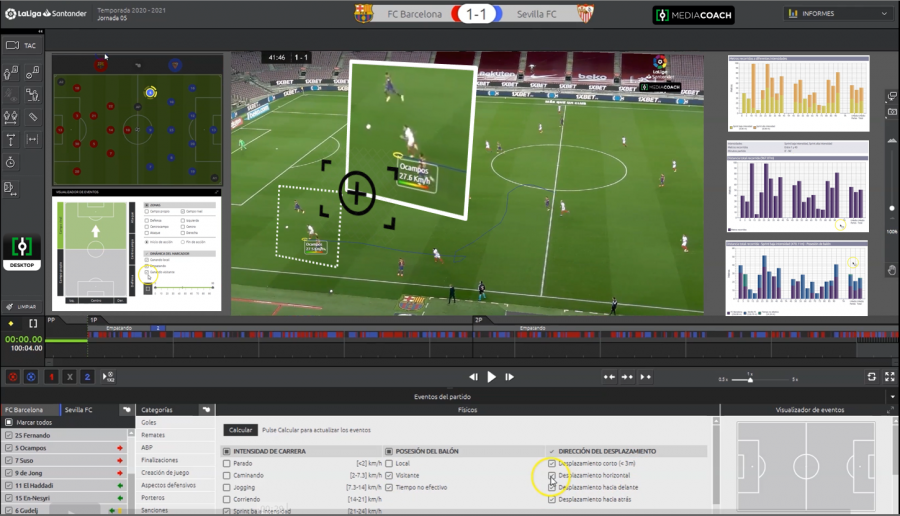
- LaLiga’s real-time match data and analytics platform Mediacoach is now helping clubs to monitor the physical condition of their players.
- The data has reached such a level of accuracy that physical and coaching stuff are using it to make key decisions during live matches.
Player injuries can present huge disruption to a club’s season, with on-field results, titles or league placement at stake. While eliminating injuries from a physical sport such as football is near impossible, technology is making it easier for LaLiga clubs to detect meaningful patterns that lead to a reduction in cases.
Recent evidence suggests that certain muscular problems are closely related to minutes accumulated across training sessions and competitive matches. Clubs are turning to new tools that can provide data to coaches and fitness staff that can assist with real-time decision-making and minimising injury risk.
During training sessions, this data can be collected through GPS devices that players wear on their bodies, which are also permitted for use during competitive matches in Spain. But LaLiga also offers a less-invasive form of tracking thanks to Mediacoach, a tool based on pitch-side cameras that provides accurate information about each player’s physical condition, without relying on external factors such as battery life, climate or GPS signal.
Using Mediacoach, LaLiga clubs are analysing their players in real-time to adjust tactics during the match, but also to assess the physical demand that is being put on the players and determine whether a substitution is necessary. Over time, they are building up unique profiles of their squad members and their individual characteristics, shaping their training sessions and match tactics accordingly.
“Each team will have demands that they need to respond to and, thanks to the data that comes from Mediacoach, they can look at an abundance of stats about their players over the course of one season or several,” explained Fabio Nevado, a technical football analyst in the sporting investigations department and the Mediacoach team. “This can help them to construct a profile or even work out the profile of a certain position. In other words, they can come to understand what the demands of competitive action are for each one of the positions on the pitch.”
Avoiding the risk zone
Mediacoach, which is available to all LaLiga clubs in desktop and mobile versions, allows all club staff to access performance data during matches in real time, even creating alerts that can be preconfigured before the start of a match.
“For example, it can be set up for a physical trainer to be notified when a certain player reaches a certain figure in terms of distance covered or number of sprints,” Nevado said. “This makes is possible to see the player’s performance levels in any given moment.”
This helps teams to take decisions with the aim of minimising the risk of injury and also to monitor players who have recently returned from injury, helping them to stay within certain limits and avoid the risk of the injury recurring.
“It’s not about predicting injuries, but detecting thresholds regarding players’ levels of physical load, and where they might enter a risk zone,” said Ricardo Resta, the director of LaLiga’s sporting investigations department and the Mediacoach team. “There are players who suffer injuries without exceeding these thresholds and many others who don’t suffer issues even when they’ve gone past these values. Not everything can be measured. But what we’re talking about is identifying levels of risk as a method of prevention.”
Measuring bursts of speed
When an injury is diagnosed, clubs study the performance levels that the player had in the weeks before the injury to map out a potential pattern that could help with identifying and bringing forward a response the next time a similar pattern is detected.
There are countless variables within Mediacoach that can be studied to help minimise risks over time. One metric of current interest is the ground covered by a player while running at a velocity of more than 24 km/h, or distance covered when the player is reaching maximum velocity.
“It seems that these bursts of effort at such a high intensity are related the most to muscular injuries,” Nevado continued. “Acceleration and deceleration are studied too, which are metrics that couldn’t be accurately measured until recently. Fortunately, our technology has evolved enough to achieve this.”
The Sevilla FC example
Fitness staff at Spanish clubs can now work with LaLiga to adapt the data from Mediacoach to fit their own quantification and control methods. Each club has a certain formula that they use to try to reduce the risk of injuries and these differ based on the methodology used to the resources that are available. At Sevilla FC, care is taken to protect both the players’ physical and emotional state.
Óscar Caro and Pepe Conde, fitness trainers at Sevilla FC, noted: “In our case, we’ve opted to use GPS devices during training and Mediacoach during matches. We wanted to make sure the players are as comfortable as possible during matches and to respect what we’d call ‘the mystique’ of the moments just before a match. We prefer to accept the slight differences that there may be between these two methods of calculation, which we know are minimal, than to interfere during the sacred space of the pre-match build-up.”
At the Andalusian club, data is seen as an indicator for something that might eventually happen. “Data on its own says little,” the trainers added. “What we try to do is to find indicators that can help us anticipate an injury. Nowadays we can build very reliable warning limits thanks to the developments in the tools we use, thanks to the advancements in scientific knowledge and the improved use of data.”
“Some metrics can advise us if a footballer is producing data beyond their usual levels and, looking at these tendencies, we can calculate upwards or downwards spikes that need to be analysed in greater detail,” the trainers continued. “It’s very important that the information obtained can lead us to a practical application. If not, then the data becomes useless.”
Caro and Conde also pointed out the importance of the correlation between quantitative and qualitative data. “A player can be influenced by different factors, including emotional or social ones,” they said. “It would be a mistake to not consider or correlate the quantitative data with the qualitative and subjective data. You need to know how to listen to the footballer, as the information the player can give us is extremely valuable in the injury prevention process and in the performance optimisation process.”
The staff at Sevilla FC add that it is vital to know how to select the variables that are needed out of available data. “We need to select the data that truly helps us to make modifications to the structure and design of a training session,” Caro and Conde added. “Analysing less useful data could be a waste of time and it’s important to avoid that when it comes to working in elite sport, even more so with the busy schedule of competition that we have right now.”
Earning the trust of clubs
LaLiga has been working on Mediaocach for many years in order to grow the platform and integrate it with LaLiga Santander and LaLiga SmartBank clubs.
Roberto López, the coordinator of the Mediacoach project and the sporting investigations department, said:
“Initially, the clubs had greater trust in data that was produced by the devices placed on the players’ bodies than data produced from cameras. But thanks to the robust work of the Mediacoach team to try to highlight the quality of our information, we have earned greater recognition.”
This trust has also been achieved thanks to the publication of studies that show the multi-camera technology used by Mediacoach delivers results that are as accurate, or more accurate, than GPS readings.
Citing a recent study that appeared in the scientific journal PLOS ONE, López added: “We worked with FC Barcelona’s B team with eight players wearing a GPS device during matches, then we compared this data with our cameras,” López added. “The results showed that for certain metrics, like distance covered, the difference between the two readings was less than 1%. The results were practically the same.”
Informing tough coaching decisions
With a particularly congested fixture list this season owing to the disruption of the pandemic, looking after the health of the players has become an even more pressing concern for football clubs. Line-up rotations can help increase rest time for players, but with every result potentially crucial to the season, coaches are naturally reluctant to leave out their best players. Using data is helping more clubs to find the right balance.
“It may be that given the scoreline or importance of a match, it’s necessary for a player with high load-levels to play at a certain moment,” López said. “But thanks to Mediacoach, it’s possible for medical teams to follow the metrics live and advise coaches if certain levels are surpassed, so that they can take preventative action.”
“A coaches’ job becomes harder every year due to the need for internal decision making and the outside perception of those decisions,” Resta concluded. “There are times when onlookers don’t understand the decisions behind a certain player not being in the starting line-up or being taken off if they’ve been playing well. The reasons are more and more heavily based on data that are studied in a serious way by the professional staff working at a club. There’s a need to understand the complexity of such decisions, which are carefully weighed up based on potential results and consequences.”
